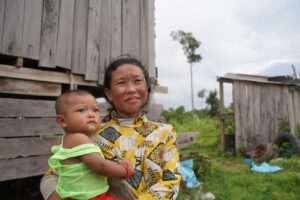
Green Feeding Tool
 Calculating the environmental gains from breastfeeding
Calculating the environmental gains from breastfeeding
Breastfeeding is representative of how valuable unpaid care work can be overlooked in economic policies. At the same time, breastfeeding goes unnoticed for its positive impact on the environment. By calculating the greenhouse gas emissions and water use from the production and consumption of commercial milk formula, the Green Feeding Tool is to provide economic and environmental metrics that support advances in global breastfeeding rates.
A breakthrough innovation – A new idea, model, product, or service in a new market. We partner with the Australian National University.
Challenging the Status Quo to Impact Nutrition
Q: What solution is offered by this innovation?
Manufactures of commercial milk formula surge Greenhouse Gas (GHG) emissions and negative environmental impacts. In 2018, two million tons of milk formula was sold globally–equating to between 14 and 28 million tons of GHG emissions and ten million cubic meters of water.
Breastfeeding also continues to go unrecognised as a form of unpaid care work that is vital for thriving individuals and societies. Around the world, women often experience inadequate paid maternity leave, sub-optimal support from family members and employers. In addition, they are compounded by aggressive marketing and ready availability of infant formula.
The Green Feeding Tool clarifies the environmental cost of commercial milk formula production and consumption through gas emission and water use calculations. Accordingly, it adds value to existing advocacy efforts focused on the health, social, and economic benefits of breastfeeding.
Q: What is most exciting about the Green Feeding Tool?
We urgently need smart innovations to slow and mitigate climate change. Recently, the issue of the harmful impact of commercial milk formula production on the environment has been hot on social media–even if governments are not yet engaged, people and related research are talking about it. Our innovation responds to this evidence gap, providing easy to use metrics for advocates fighting for improved breastfeeding practices in line with the World Health Organization targets. It is inexpensive to run and can be easily adapted.
Q: How does the Green Feeding Tool support system wide change?
The Green Feeding Tool enables policymakers, advocates, environmentalists, and climate change scientists to evaluate the reduction in GHG emissions by increased breastfeeding and reduced reliance on commercial milk formula. We have the potential to positively influence the design of policies and programs across food and health systems to reduce GHS and climate related impacts.
Our innovation also encourages food and health policymakers and public officials to include breastfeeding in food balance sheets and economic statistics. In the long run, such a change would alter the dialogue on breastfeeding and could lead to more supportive policies and investment for women and their babies, which, over time, can improve breastfeeding rates.
Looking Ahead: Lessons for our Impact Network
We experienced challenges finding available data and defining an appropriate regression model for the tool. As such, we searched for data from various sources online, performed literature reviews, and consulted climate change advocates, environmentalists, economists, and nutritionists about model designs.
We have begun the process of developing an offline and easy-to-use excel tool with calculations for a list of countries. After which, we will collect user feedback to improve the tool and develop an online tool. We will also adapt to several major languages.
In the next five years, we envisage the uptake of the Green Feeding Tool to policymakers, environmentalists, and environmental and breastfeeding associations and will endeavour to see its application in policy and program designs.